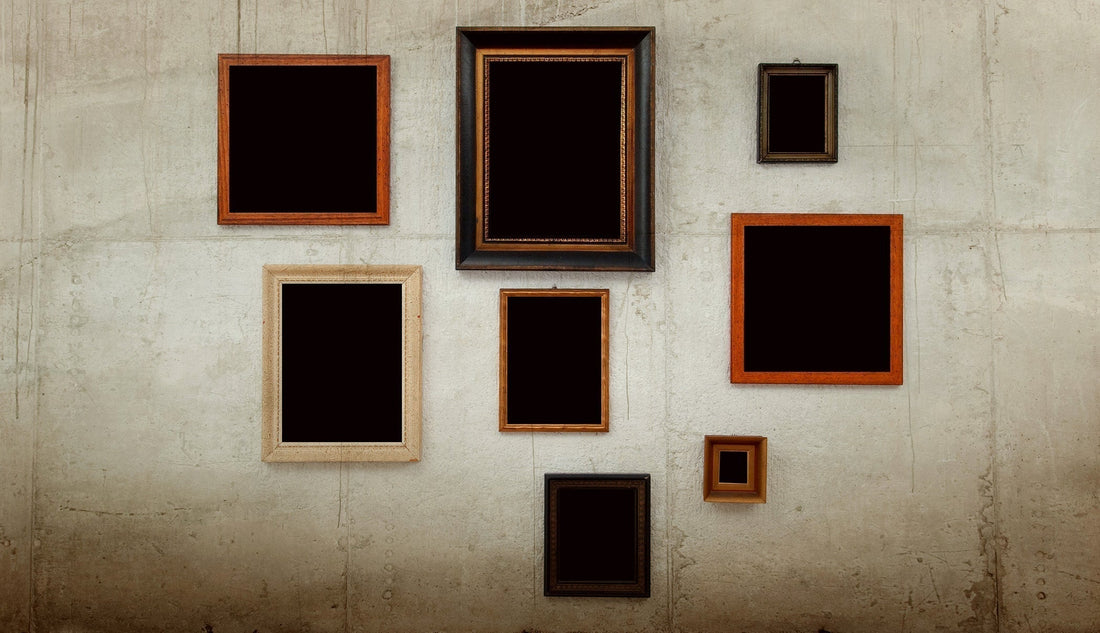March 2025
Trends in 2025 for Framing, Hanging, Placement and Layout of Wall Art.
As we step further into 2025, it is becoming apparent that wall décor is taking on a fresh, dynamic role in home design. This year, the placement of wall art is all about creating focal points that reflect personality and style. From gallery walls that blend eclectic pieces to oversized statement art that dominates entire rooms, the trends emphasise balance and intentionality. Whether it’s arranging art around architectural features like windows or using mirrors to expand space, the focus is on making each piece an integral part of the room’s design, offering both aesthetic appeal and functionality.

This year’s wall art trend is shifting from the carefully designed and symmetrical layouts of previous years.
In 2025, gallery walls are dominant and embrace a more layered look and an eclectic style, showcasing a variety of art forms, frame styles, sizes, and vibrant patterns to enhance the overall aesthetics of a room. Wall art in a gallery style layout tells a visual story creating an organic, flowing design that feels curated but not overly controlled.
Consider stepping out and extend creativity by incorporating floating frames, shadow boxes and even round frames for a unique and eclectic look into your gallery wall.
The use of different frame styles, colours and materials are being incorporated into a space to create that curated and eclectic look. Modern sleek frames are mixed with vintage frames or metal, and wood frames are being used in the same space for visual contrast.
There is an intentional focus on enhancing well-being through wall spaces that promote mental, physical, and emotional health. In the layout of a wall art space trends are inclined towards sustainability, personalisation, and technology is playing a greater part. Be open to personalisation and creative self-expression by creating gallery walls with a mix of framed artwork, photographs, and even textiles.
Picture framing goes beyond protecting your chosen artwork or that meaningful photograph; it plays an important role in presenting your wall art in a fitting yet creative way. That right frame can enhance a print, providing depth, dimension, and provide an expression of individuality and personality. There are many frame choices available but the trends for 2025 include floating frames which are increasing in popularity as it puts the focus on the art, while the frame adds a finished touch without dominating the artwork.
In 2025 bright and bold frames as well as vintage and retro style frames are becoming more sought after. There is an emphasis on frames made from recycled materials such as reclaimed wood or metal that are more environmentally friendly. For wooden frames lighter wood like an oak, beech, maple and ash are the preferred look often left in their natural state or lightly stained and varnished to show off the grain. The trend is to mix and match frames adding a pop of individuality and personality to a space.
Shadow box frames are a great way to display three - dimensional objects including mixed media, natural objects, found objects, trinkets, medals, souvenirs or family memorabilia. Shadow boxes will be used in more creative ways in 2025 bringing character and personalisation to a space.
When it comes to the layout, placement and hanging of wall art, the trends in 2025 focus on creativity, personality, balance, and making the most of your wall or chosen space.
When placing artwork, a wall is not the only space to place art. Wall art can be placed on a shelf, side table, mirrors, bookcase, cabinet, the floor, a buffet or lean against furniture. Artwork can be placed on a music stand, recipe book holder, or a plant stand.

The ideal number of pictures to hang on a wall is a decision that should be based on the wall's dimensions and the room's overall aesthetic. It's essential to consider the wall's scale along with the sizes of the artwork you wish to showcase. Larger pieces are often better suited to a blank wall, while smaller artworks can enhance a shelf, desk or a hall or side table.
Spacing and proportion are important factors to consider when hanging wall art collections. Be open to experiment with artworks, prints and photographs that are close together or have wide gaps. It is more common to leave a gap of 5.08cm-10.16cm or 2-4 inches between the frames. Consistent gaps lend to a more formal appearance, while varied spacing might offer a more relaxed, eclectic vibe. In the end it is about getting proportion and balance for your space and creating visual interest. To maintain visual proportion wall art or a wall art collection should occupy 2/3 of the size of the nearby object, such as a lampshade, couch, or side table etc. By doing this the wall art compilation should be balanced and harmonious within the space.
To arrange two wall artworks, if possible, hang them at equal distance from either end of the wall. Ideally there should be a proportional amount of blank wall space between the two. In general for artwork placement hang the artwork at average eye-level. This is about 145cm or 57 inches from the floor. For a collection of artworks, treat the group as a single unit and hang the centre of the group at eye level.
If it looks balanced and in proportion hang art 15.24cm or 6 inches above furniture if it is in proportion to the height of the wall. There are other ways to display artworks.

Art can be arranged on walls in rows and columns with equal spacing between uniform sized frames. Layer artworks with one frame slightly over the other or display in groups of odd numbers. Arrange a staircase step collection of artworks. A single artwork can be placed over a mantle or sideboard. Hang on clipboards, a casual way to style a space. A vertical display of artwork is yet another option and brings a point of difference.
These trends emphasise an approach for styling, hanging, arranging, and designing the layout of your wall art. The essential aspect is discovering a configuration that enhances your room’s atmosphere while giving your artwork a creative edge and an individualised curation. Allow your art to showcase your style and serve as a unique expression of your story.

